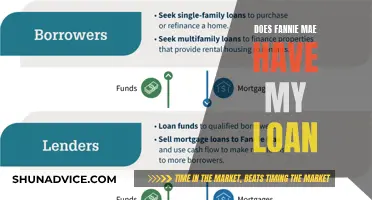
The Federal National Mortgage Association, commonly known as Fannie Mae, is a government-sponsored enterprise that buys and guarantees mortgages in the secondary mortgage market. In doing so, it creates liquidity for lenders, allowing them to underwrite or fund additional mortgages. Fannie Mae also pools the mortgages it purchases to form mortgage-backed securities (MBS), which it then sells to investors. While Fannie Mae does not originate loans for homeowners, it plays a significant role in the mortgage market by setting guidelines and criteria for the loans it will accept for purchase, known as \conforming\ loans. In recent years, Fannie Mae has been involved in selling billions of dollars worth of reperforming loans, including distressed single-family mortgages.
| Characteristics | Values |
|---|---|
| Does Fannie Mae sell distressed loans? | Yes, Fannie Mae has been known to sell distressed loans. In 2023, it put a $2.65 billion package of previously distressed single-family mortgages up for sale. |
| Type of company | Fannie Mae is a government-sponsored enterprise (GSE) and a publicly traded company. |
| Year founded | 1938 |
| Purpose | To expand the secondary mortgage market by securitizing mortgage loans in the form of mortgage-backed securities (MBS), allowing lenders to reinvest their assets into more lending. |
| How it makes money | By borrowing at low rates and reinvesting its borrowings into whole mortgage loans and mortgage-backed securities. |
| Mortgages purchased | Fannie Mae purchases mortgages from approved sellers that meet its strict criteria and packages them into mortgage-backed securities (MBS). |
| Mortgages sold | Fannie Mae sells MBS to investors in the secondary mortgage market, along with a guarantee of timely principal and interest payments. |
| Impact on the market | By purchasing mortgages, Fannie Mae provides liquidity to the market, enabling lenders to make more loans and keeping the real estate market afloat. |
| Loan modifications | Fannie Mae allows for loan modifications to help borrowers avoid default and foreclosure. Modifications can include lower interest rates and extended loan terms. |
What You'll Learn

Fannie Mae's role in the secondary mortgage market
The Federal National Mortgage Association (FNMA), better known as Fannie Mae, is a government-sponsored enterprise (GSE) founded in 1938 by Congress during the Great Depression. As part of the New Deal, it was established to stimulate the housing market by making more mortgages available to moderate- to low-income borrowers.
Fannie Mae does not extend mortgages to borrowers, but it does purchase and guarantee them through the secondary mortgage market. That reduces the risks to banks, making them more willing to loan money. In fact, Fannie Mae is one of two of the largest purchasers of mortgages on the secondary market. The other is its sibling, the Federal Home Loan Mortgage Corporation, or Freddie Mac, another government-sponsored enterprise created by Congress.
Fannie Mae and Freddie Mac buy mortgages from lenders and either hold these mortgages in their portfolios or package the loans into mortgage-backed securities (MBS) that may be sold. Lenders use the cash raised by selling mortgages to the enterprises to engage in further lending. The enterprises' purchases help ensure that individuals and families that buy homes and investors that purchase apartment buildings and other multifamily dwellings have a continuous, stable supply of mortgage money.
Fannie Mae provides liquidity to the markets by buying mortgages and pooling them into mortgage-backed securities, thus freeing up lenders to offer more mortgages. In the first three quarters of 2024, Fannie Mae provided $274 billion in liquidity to the mortgage market. In 2022, Fannie Mae helped 542,740 people buy their own homes for the first time. It helped 2.6 million households buy, refinance, or rent a home. By buying mortgages, it added $648 billion in liquidity to the banking system.
Loans and Financial Intermediaries: An Inevitable Partnership?
You may want to see also

The impact of distressed loans on borrower outcomes
To avoid default, distressed borrowers can employ strategies such as forbearance, reinstatement, or loan modifications. Forbearance involves the suspension of payment obligations for a specific period, but lenders rarely grant this option unless required by law. Reinstatement, which is more commonly required by lenders, involves paying the delinquent amount in a lump sum. Loan modifications can include lowering the interest rate or extending the loan term to reduce monthly payments, and lenders may offer this option if they fear the borrower will otherwise default entirely. In some cases, distressed borrowers may also have the option of a short sale, selling their property at a loss and repaying the lender less than the full amount owed.
Fannie Mae, a government-sponsored enterprise, plays a role in the secondary mortgage market by purchasing and guaranteeing mortgages, which helps create liquidity for lenders and makes loans more accessible to low- and moderate-income borrowers. While Fannie Mae does not originate loans, its investment in the mortgage market allows lenders to underwrite or fund additional mortgages. However, to resell loans, Fannie Mae and its counterpart Freddie Mac must ensure the loans are considered safe investments, and thus they have strict guidelines for the mortgages they will purchase. These guidelines give Fannie Mae a significant role in determining which mortgage applicants are eligible for loans.
When foreclosures occur on mortgages in which Fannie Mae is the owner or investor, the enterprise attempts to sell the properties promptly to minimize the impact on the community. Through the HomePath program, creditworthy homebuyers can finance new homes, and special financing options may be available, such as closing cost assistance and lower down payments. While distressed loans can lead to negative outcomes for borrowers, such as default and foreclosure, various strategies and alternatives are available to mitigate these risks and help borrowers stay in their homes.
Fannie Mae's Stance on PACE Loans
You may want to see also

Fannie Mae's loan modification options
Fannie Mae does not directly offer mortgages to borrowers; instead, it buys and guarantees mortgages through the secondary mortgage market. This means that it does not directly offer loan modifications to borrowers either. However, it does provide a framework for loan modifications that lenders can use to help borrowers avoid default and foreclosure. This is known as the Fannie Mae Flex Modification.
The Fannie Mae Flex Modification is available to borrowers who are experiencing permanent or long-term hardship and can no longer afford to make regular monthly mortgage payments. To be eligible, the borrower's mortgage loan must be current or less than 90 days delinquent. The modification aims to achieve a 20% principal and interest payment reduction target, which can be done through an interest rate reduction or by extending the remaining loan term.
The process for the Fannie Mae Flex Modification involves the borrower submitting a Borrower Response Package (BRP) and the lender evaluating the borrower's hardship, total income, and assets. The lender must then determine the borrower's eligibility for the modification and communicate the terms, which are not binding until all conditions are satisfied. The borrower must then execute and return the necessary documentation, and the lender must document the borrower's Trial Period Plan.
It is important to note that not all modifications will result in a 20% payment reduction, and the specific terms of the modification may vary depending on the borrower's circumstances. Additionally, Fannie Mae's guidelines for loan modifications are extensive, and lenders must comply with federal regulations to ensure safe investments.
Factoring: Understanding Loan Factor and Its Impact
You may want to see also

The process of securitizing and selling distressed loans
Fannie Mae does not originate loans for homeowners but buys and guarantees mortgages through the secondary mortgage market. It creates more liquidity for lenders, including banks, thrifts, and credit unions, allowing them to underwrite or fund additional mortgages.
Fannie Mae and Freddie Mac operate in the secondary mortgage market, where they buy mortgages from lenders and repackage them as mortgage-backed securities (MBS). MBS are asset-backed securities secured by a mortgage or pool of mortgages. After purchasing mortgages on the secondary market, Fannie Mae pools them to form MBS. The mortgages it purchases and guarantees must meet strict criteria. For example, the limit for a conventional loan for a single-family home in 2023 is $726,200 for most states, as well as the District of Columbia and Puerto Rico.
Securitization is the financial practice of pooling various types of contractual debt, such as residential mortgages, commercial mortgages, auto loans, or credit card debt obligations, and selling their related cash flows to third-party investors as securities. These securities may be described as bonds, pass-through securities, or collateralized debt obligations (CDOs). Securitization allows the original lender or creditor to remove assets from its balance sheets to underwrite additional loans. It also promotes liquidity in the marketplace.
The process of securitization involves several steps:
- Asset origination: The process begins with a lender, such as an investment bank, issuing loans to borrowers.
- Transfer the assets: The lender sells the pool of loans to a special purpose vehicle (SPV), removing the assets from its balance sheet.
- Tranching: The SPV divides the pool of loans into different risk classes, known as tranches. Each tranche has a different level of risk and return, catering to different investor risk appetites.
- Credit enhancement: The SPV may use various techniques, such as over-collateralization, to make the securities more attractive to investors.
- Rating: The SPV hires credit rating agencies to assess the creditworthiness of each tranche.
- Issuance: The SPV issues tradable securities with a stake in the assets in the portfolio.
- Investment: Investors buy the new securities for a specific rate of return and effectively take on the role of the lender.
Renovation Loans: Fannie Mae's HomeStyle Loan Option
You may want to see also

The guidelines for selling distressed loans
Selling distressed debt is a strategic move that helps lenders improve their portfolio by divesting non-performing or problematic loans. This improves their creditworthiness and attracts more favourable terms for future borrowings. It also helps them comply with regulatory requirements and address credit risk.
When a company is going bankrupt, it can sell its debt, also known as distressed debt or non-performing loans. Distressed debt is often sold at a discount to specialised third-party investors who possess expertise in distressed assets. This allows lenders to recover a portion of the outstanding debt without incurring additional costs associated with collections or legal proceedings.
A distressed sale refers to the urgent sale of assets such as securities and property at a significant discount from the market price to quickly cover urgent debts, medical expenses, and other emergencies. This type of sale often occurs when a business is making losses or is on the verge of insolvency. The buyers of distressed assets may need to spend a significant amount of money on repairs, as the sellers are in a hurry to sell and probably haven't performed any required maintenance.
Fannie Mae, a government-sponsored enterprise, does not sell distressed loans. Instead, it buys and guarantees mortgages through the secondary mortgage market, creating more liquidity for lenders. It then pools these mortgages to form mortgage-backed securities (MBS), which are purchased by institutions such as insurance companies and investment banks.
Fannie Mae's guidelines for purchasing mortgages are detailed in its Selling Guide, which runs over 1,200 pages. For example, for 2025, the maximum loan limit Fannie Mae will purchase is set at a certain amount. It does not purchase "jumbo" financing or larger loans. These guidelines help determine which mortgage applicants are eligible for loans.
Fafsa and Loan Providers: Who Chooses?
You may want to see also
Frequently asked questions
The Federal National Mortgage Association (FNMA), commonly known as Fannie Mae, is a United States government-sponsored enterprise (GSE) and, since 1968, a publicly traded company.
Yes, Fannie Mae does sell distressed loans. In 2023, Fannie Mae put a $2.65 billion package of previously distressed single-family mortgages up for sale.
A distressed loan is a loan that has a high risk of default.
Fannie Mae helps borrowers by modifying loan conditions to avoid default, foreclosure, and losing their homes. Modifications can include lower interest rates and extending the loan term, resulting in lower monthly payments.







